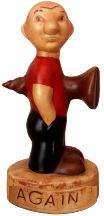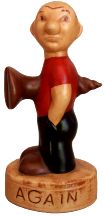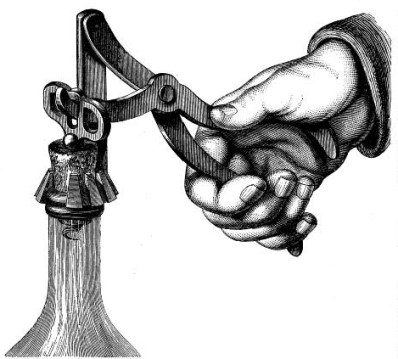 |
 The Virtual Corkscrew Museum's Weekly Newspaper |
 |
 |
 The Virtual Corkscrew Museum's Weekly Newspaper |
 |
|
Sunday, March 8, 2009 |
Number 546 |
Morton's Lever

From the September 4, 1869 issue of the Scientific American: "Improved Cork Extractor. Our engraving shows a simple and powerful implement for extracting corks from bottles, patented Jan. 14, 1868, by James Morton, of Philadelphia. It consists of three bars pivoted together, which, together with the corkscrew, constitute the entire apparatus. One of the bars has a socket or cap at its lower end, which is placed on and around the nose of the bottle. Near the upper end of this first post or bar is pivoted the end of the second bar, near the middle of which the third bar is pivoted. The second and third bars have handles at their outer ends, and at the inner end of the third bar is a hook. This hook engages with the corkscrew in the manner delineated in the engraving, and by forcing the handles together or pressing them downward, the cork can be easily extracted. The instrument is equally adapted to extracting corks on which rings or hooks are already formed so that no corkscrew is needed. For further particulars address James Morton, 912 South Eighth street, Philadelphia, Pa."
Compare the Scientific American's engraving to the Morton's patent drawing shown below.
Corkscrew collectors are much more familiar with the Lund's 1855 patent lever discussed with a photo gallery in the August 1, 2008 issue. What else did Lund do? Here's an listing from the 1884 Business Directory of London:
Put Some Spring in Your Step
Numerous news reports in December, 1953 featured the ideal gift for Christmas --- the corkscrew heel from shoe designer Andre Perugia (1893-1977). The press release read "Spring in your step - A spiraling 'corkscrew' heel made of gilded metal with matching strips across the instep lends a futuristic air to Andre Perugia's latest pump. The shoe is included in a custom collection of metal-shanked footwear designed for a swank New York City shop." Perugia designed the shoe in 1952 in Paris and when introduced in New York it became a success.
Perugia trademarked his signature in 1928.
Corkscrew Brushes
Reader Ron MacLean wrote: "Have you ever wondered how the brushes were put in an English corkscrew? About three years ago I was given an early 19th century English corkscrew marked J. WHEELER that had the original brush still present. The brush insert had dried up and loose in the handle end but had not fallen out. I have attached a picture showing the brush which was initially wrapped with a thin cord (hemp/ linen?) and then glued in place. Inside the brush socket hole were remnants of the cord as often seen in handle sockets when brushes are lost or removed."
Winding Down
A napkin - submitted by Ron MacLean
|
©2009 Don Bull, Editor |